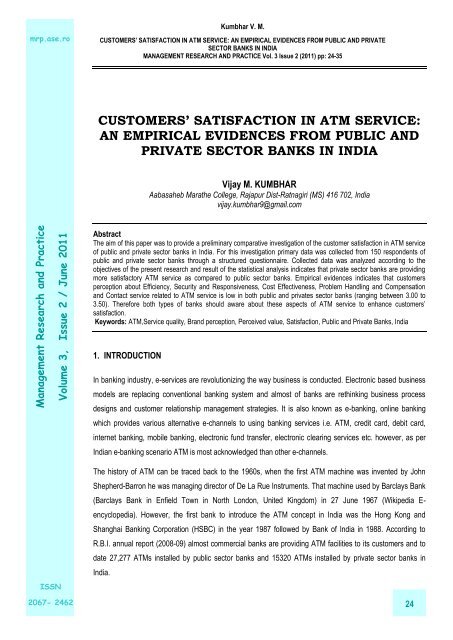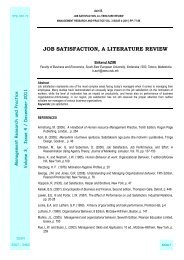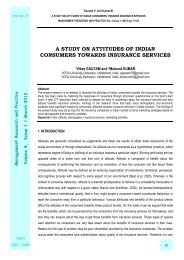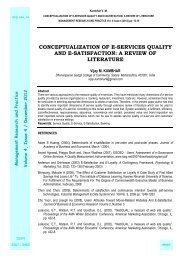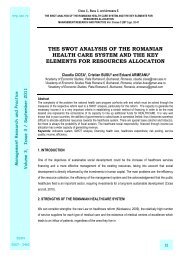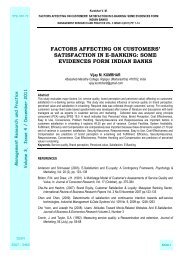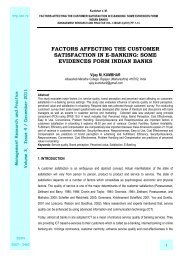customers' satisfaction in atm service - Management Research and ...
customers' satisfaction in atm service - Management Research and ...
customers' satisfaction in atm service - Management Research and ...
You also want an ePaper? Increase the reach of your titles
YUMPU automatically turns print PDFs into web optimized ePapers that Google loves.
mrp.ase.ro<br />
<strong>Management</strong> <strong>Research</strong> <strong>and</strong> Practice<br />
ISSN<br />
2067- 2462<br />
Volume 3, Issue 2 / June 2011<br />
Kumbhar V. M.<br />
CUSTOMERS’ SATISFACTION IN ATM SERVICE: AN EMPIRICAL EVIDENCES FROM PUBLIC AND PRIVATE<br />
SECTOR BANKS IN INDIA<br />
MANAGEMENT RESEARCH AND PRACTICE Vol. 3 Issue 2 (2011) pp: 24-35<br />
CUSTOMERS’ SATISFACTION IN ATM SERVICE:<br />
AN EMPIRICAL EVIDENCES FROM PUBLIC AND<br />
PRIVATE SECTOR BANKS IN INDIA<br />
Vijay M. KUMBHAR<br />
Aabasaheb Marathe College, Rajapur Dist-Ratnagiri (MS) 416 702, India<br />
vijay.kumbhar9@gmail.com<br />
Abstract<br />
The aim of this paper was to provide a prelim<strong>in</strong>ary comparative <strong>in</strong>vestigation of the customer <strong>satisfaction</strong> <strong>in</strong> ATM <strong>service</strong><br />
of public <strong>and</strong> private sector banks <strong>in</strong> India. For this <strong>in</strong>vestigation primary data was collected from 150 respondents of<br />
public <strong>and</strong> private sector banks through a structured questionnaire. Collected data was analyzed accord<strong>in</strong>g to the<br />
objectives of the present research <strong>and</strong> result of the statistical analysis <strong>in</strong>dicates that private sector banks are provid<strong>in</strong>g<br />
more satisfactory ATM <strong>service</strong> as compared to public sector banks. Empirical evidences <strong>in</strong>dicates that customers<br />
perception about Efficiency, Security <strong>and</strong> Responsiveness, Cost Effectiveness, Problem H<strong>and</strong>l<strong>in</strong>g <strong>and</strong> Compensation<br />
<strong>and</strong> Contact <strong>service</strong> related to ATM <strong>service</strong> is low <strong>in</strong> both public <strong>and</strong> privates sector banks (rang<strong>in</strong>g between 3.00 to<br />
3.50). Therefore both types of banks should aware about these aspects of ATM <strong>service</strong> to enhance customers’<br />
<strong>satisfaction</strong>.<br />
Keywords: ATM,Service quality, Br<strong>and</strong> perception, Perceived value, Satisfaction, Public <strong>and</strong> Private Banks, India<br />
1. INTRODUCTION<br />
In bank<strong>in</strong>g <strong>in</strong>dustry, e-<strong>service</strong>s are revolutioniz<strong>in</strong>g the way bus<strong>in</strong>ess is conducted. Electronic based bus<strong>in</strong>ess<br />
models are replac<strong>in</strong>g conventional bank<strong>in</strong>g system <strong>and</strong> almost of banks are reth<strong>in</strong>k<strong>in</strong>g bus<strong>in</strong>ess process<br />
designs <strong>and</strong> customer relationship management strategies. It is also known as e-bank<strong>in</strong>g, onl<strong>in</strong>e bank<strong>in</strong>g<br />
which provides various alternative e-channels to us<strong>in</strong>g bank<strong>in</strong>g <strong>service</strong>s i.e. ATM, credit card, debit card,<br />
<strong>in</strong>ternet bank<strong>in</strong>g, mobile bank<strong>in</strong>g, electronic fund transfer, electronic clear<strong>in</strong>g <strong>service</strong>s etc. however, as per<br />
Indian e-bank<strong>in</strong>g scenario ATM is most acknowledged than other e-channels.<br />
The history of ATM can be traced back to the 1960s, when the first ATM mach<strong>in</strong>e was <strong>in</strong>vented by John<br />
Shepherd-Barron he was manag<strong>in</strong>g director of De La Rue Instruments. That mach<strong>in</strong>e used by Barclays Bank<br />
(Barclays Bank <strong>in</strong> Enfield Town <strong>in</strong> North London, United K<strong>in</strong>gdom) <strong>in</strong> 27 June 1967 (Wikipedia E-<br />
encyclopedia). However, the first bank to <strong>in</strong>troduce the ATM concept <strong>in</strong> India was the Hong Kong <strong>and</strong><br />
Shanghai Bank<strong>in</strong>g Corporation (HSBC) <strong>in</strong> the year 1987 followed by Bank of India <strong>in</strong> 1988. Accord<strong>in</strong>g to<br />
R.B.I. annual report (2008-09) almost commercial banks are provid<strong>in</strong>g ATM facilities to its customers <strong>and</strong> to<br />
date 27,277 ATMs <strong>in</strong>stalled by public sector banks <strong>and</strong> 15320 ATMs <strong>in</strong>stalled by private sector banks <strong>in</strong><br />
India.<br />
24
mrp.ase.ro<br />
<strong>Management</strong> <strong>Research</strong> <strong>and</strong> Practice<br />
ISSN<br />
2067- 2462<br />
Volume 3, Issue 2 / June 2011<br />
Kumbhar V. M.<br />
CUSTOMERS’ SATISFACTION IN ATM SERVICE: AN EMPIRICAL EVIDENCES FROM PUBLIC AND PRIVATE<br />
SECTOR BANKS IN INDIA<br />
MANAGEMENT RESEARCH AND PRACTICE Vol. 3 Issue 2 (2011) pp: 24-35<br />
1.1. <strong>Research</strong> Gap<br />
The review of literature suggest that most of the studies have been done on issues related to Internet bank<strong>in</strong>g<br />
<strong>in</strong> countries like USA, UK, Malaysia, S<strong>in</strong>gapore F<strong>in</strong>l<strong>and</strong>, Australia (Sathye, 1999; Mukti, 2000; Wang et al,<br />
2003; Gerrard <strong>and</strong> Cunn<strong>in</strong>gham, 2006 etc.) However, not sufficient work has been done <strong>in</strong> India with regard<br />
to ATM <strong>service</strong> <strong>and</strong> customer <strong>satisfaction</strong> issues. The present study <strong>in</strong>tends to know the determ<strong>in</strong>ants of<br />
customers’ <strong>satisfaction</strong> <strong>in</strong> ATM <strong>service</strong> concern regard<strong>in</strong>g Indian context.<br />
1.2. Objectives of the Study<br />
� To exam<strong>in</strong>e the customers’ <strong>satisfaction</strong> <strong>in</strong> ATM <strong>service</strong> provided by Public <strong>and</strong> private sector banks.<br />
� To analysis gap between expectation <strong>and</strong> perception of ATM <strong>service</strong> quality, br<strong>and</strong> perception <strong>and</strong><br />
perceived value <strong>in</strong> ATM <strong>service</strong> of public <strong>and</strong> private sector banks.<br />
� To offer valuable suggestions to improve ATM <strong>service</strong> of both public <strong>and</strong> private sector banks.<br />
2. REVIEW OF LITERATURE<br />
The market<strong>in</strong>g literature clears that, the customer <strong>satisfaction</strong> is measured via <strong>service</strong> quality <strong>and</strong> <strong>service</strong><br />
quality measured by various measurement tools <strong>and</strong> <strong>in</strong>struments developed by various researchers <strong>and</strong><br />
market<strong>in</strong>g consultancy organisations e.g. SERVQUAL, SERVPERF, SITQUAL, WEBQUAL, etc. A number of<br />
studies specifically address the role of <strong>satisfaction</strong> <strong>in</strong> <strong>service</strong> contexts. <strong>Research</strong> literature suggests that<br />
<strong>service</strong> quality is a more specific judgement which can lead to a broad evaluation of customer <strong>satisfaction</strong><br />
(Oliver, 1993; Parasuraman et al, 1985, 1988, 2005; Cron<strong>in</strong> <strong>and</strong> Taylor, 1994). The higher level of perceived<br />
<strong>service</strong> quality results <strong>in</strong> <strong>in</strong>creased customer <strong>satisfaction</strong>. When perceived <strong>service</strong> quality is less than<br />
expected <strong>service</strong> quality customer will be dissatisfied (Ja<strong>in</strong> <strong>and</strong> Gupta, 2004). In e-<strong>service</strong> era e-<strong>service</strong><br />
quality is important aspect of measur<strong>in</strong>g customer <strong>satisfaction</strong> (Parasuraman et al, 2005, Loiacono <strong>and</strong><br />
Goodhue, 2000; Yoo <strong>and</strong> Donthu, 2001; Zeithaml et al, 2000; Nadiri et al., 2009 etc.). Table no 1 reveals that<br />
there are various dimensions of <strong>service</strong> quality has been used by different researchers to assess <strong>service</strong><br />
quality <strong>and</strong> customers’ <strong>satisfaction</strong>.<br />
Apart from <strong>service</strong> quality br<strong>and</strong> perception <strong>and</strong> perceived value also plays crucial role <strong>in</strong> customer<br />
<strong>satisfaction</strong> <strong>in</strong> <strong>service</strong> <strong>in</strong>dustry. Market<strong>in</strong>g literature exam<strong>in</strong>ed positive l<strong>in</strong>k between the <strong>satisfaction</strong> <strong>and</strong> the<br />
br<strong>and</strong> image <strong>and</strong> br<strong>and</strong> perception (Woodruff et al., 1983; Wafa et al., 2009). An obta<strong>in</strong>ed ‘Value’ of <strong>service</strong><br />
also one of the most important factors affect<strong>in</strong>g on customers <strong>satisfaction</strong>. There are close relationship<br />
between <strong>service</strong> value <strong>and</strong> customers <strong>satisfaction</strong>. Value may be conceptualized as aris<strong>in</strong>g from both quality<br />
<strong>and</strong> price or from what one gets <strong>and</strong> what one gives (Zeithml, 2002). Value <strong>in</strong>creases as quality <strong>in</strong>creases<br />
25
mrp.ase.ro<br />
<strong>Management</strong> <strong>Research</strong> <strong>and</strong> Practice<br />
ISSN<br />
2067- 2462<br />
Volume 3, Issue 2 / June 2011<br />
Kumbhar V. M.<br />
CUSTOMERS’ SATISFACTION IN ATM SERVICE: AN EMPIRICAL EVIDENCES FROM PUBLIC AND PRIVATE<br />
SECTOR BANKS IN INDIA<br />
MANAGEMENT RESEARCH AND PRACTICE Vol. 3 Issue 2 (2011) pp: 24-35<br />
<strong>and</strong> as price/rent/charges or cost of transaction decreases. Therefore, <strong>in</strong> this study author has used three<br />
major dimensions e.g. <strong>service</strong> quality, br<strong>and</strong> perception <strong>and</strong> perceived value to assess customer <strong>satisfaction</strong>.<br />
TABLE 1 - INSTRUMENTS AND SCALE AVAILABLE TO ASSESS SERVICE QUALITY<br />
Scale By Dimensions Method<br />
SERVQUAL<br />
Parasuraman, Zeithaml<br />
<strong>and</strong> Barry (1985; 1998)<br />
Reliability, Responsiveness, Assurance, Empathy <strong>and</strong><br />
Tangibles<br />
Likert Scale<br />
SERVFERF Cron<strong>in</strong> <strong>and</strong> Taylor (1994)<br />
WebQual<br />
Loiacono, Watson <strong>and</strong><br />
Goodhue (2000)<br />
SITEQUAL Yoo <strong>and</strong> Donthu (2001)<br />
e-SQ<br />
E-S-QUAL <strong>and</strong><br />
E-RecS-QUAL<br />
GIQUAL<br />
Zeithaml, Parasuraman,<br />
<strong>and</strong> Malhotra (2000)<br />
Parasuraman, Zeithaml<br />
<strong>and</strong> Malhotra <strong>in</strong> (2005)<br />
Tsoukatos <strong>and</strong> R<strong>and</strong><br />
(2007)<br />
BANKSERV Akiran (2002)<br />
BANKZOT Nadiri et al., (2009)<br />
SOFTWARE<br />
Quality<br />
WEB-QUAL<br />
(Alternative)<br />
eTailQ<br />
Yang <strong>and</strong> Zhang (2009)<br />
Barnes <strong>and</strong> Vidgen (2002)<br />
Wolf<strong>in</strong>barger <strong>and</strong> Gilly<br />
(2003)<br />
Reliability, Responsiveness, Assurance, Empathy <strong>and</strong><br />
Tangibles<br />
Information fit to task, <strong>in</strong>teractivity, trust, responsiveness,<br />
design, <strong>in</strong>tuitiveness, visual appeal, <strong>in</strong>novativeness,<br />
websites flow, <strong>in</strong>tegrated communication, bus<strong>in</strong>ess<br />
process <strong>and</strong> viable substitute, accessibility, speed,<br />
navigability <strong>and</strong> site content.<br />
ease of use, aesthetic design, process<strong>in</strong>g speed, <strong>and</strong><br />
security<br />
efficiency, reliability, fulfilment, privacy, responsiveness,<br />
compensation, <strong>and</strong> contact<br />
Efficiency Fulfilment, System availability, Privacy,<br />
Responsiveness, Compensation <strong>and</strong> Contact<br />
Responsiveness, Assurance, Empathy, Tangibles <strong>and</strong><br />
Reliability<br />
polite, greet, help, promptness, neatness, apology,<br />
concern, mistake, security, <strong>in</strong>formed, acctypes, advice,<br />
learn, know, servwhen, teller <strong>and</strong> staff number<br />
Desired, adequate, predicted <strong>and</strong> perceived <strong>service</strong><br />
quality<br />
Completeness, Security, Adequacy, Simplicity,<br />
Self-descriptiveness, Functionality, Reliability, Facility,<br />
Efficiency etc.<br />
Usability, Design, Information, Trust, Empathy<br />
Design, Personalization, Fulfillment, reliability,<br />
privacy/security, customer <strong>service</strong><br />
3. EXPECTATION-PERFORMANCE SCALE VS PERFORMANCE ONLY SCALE<br />
Likert Scale<br />
Likert Scale<br />
Likert Scale<br />
Likert Scale<br />
Likert Scale<br />
Likert Scale<br />
Likert Scale<br />
Likert Scale<br />
Likert Scale<br />
Likert Scale<br />
Likert Scale<br />
Parasuraman, Zeithaml <strong>and</strong> Berry (1985; 1988; 2005) posited that Expectation-Performance Scale (Gap<br />
Analysis) is necessary to exam<strong>in</strong>e level of customer <strong>satisfaction</strong> <strong>in</strong> <strong>service</strong> <strong>in</strong>dustry. They argued that if there<br />
is expected quality of <strong>service</strong> <strong>and</strong> actual perceived performance is equal or near about equal there is<br />
customers can be satisfy, while a negative discrepancy between perceptions <strong>and</strong> expectations a<br />
‘performance-gap’ as they call it causes dis<strong>satisfaction</strong>, a positive discrepancy leads to consumer delight.<br />
However, Cron<strong>in</strong> <strong>and</strong> Taylor (1992; 1994) argued that customer <strong>satisfaction</strong> can be obta<strong>in</strong>able with low<br />
quality, whenever one’s expectations <strong>in</strong> a given situation are low <strong>and</strong> performance is adequate to the task.<br />
Emergency situation fit this scenario well. Similarly, dis<strong>satisfaction</strong> with high quality can ensue when some<br />
element of the <strong>service</strong> delivery is not up to personal expectations. Therefore performance only scale is<br />
suitable to assess <strong>service</strong> quality <strong>and</strong> customer <strong>satisfaction</strong>. Various researchers has used performance only<br />
26
mrp.ase.ro<br />
<strong>Management</strong> <strong>Research</strong> <strong>and</strong> Practice<br />
ISSN<br />
2067- 2462<br />
Volume 3, Issue 2 / June 2011<br />
Kumbhar V. M.<br />
CUSTOMERS’ SATISFACTION IN ATM SERVICE: AN EMPIRICAL EVIDENCES FROM PUBLIC AND PRIVATE<br />
SECTOR BANKS IN INDIA<br />
MANAGEMENT RESEARCH AND PRACTICE Vol. 3 Issue 2 (2011) pp: 24-35<br />
scale <strong>and</strong> proved that it is an excellent for measur<strong>in</strong>g <strong>service</strong> quality <strong>and</strong> customer <strong>satisfaction</strong> i.e. Pont <strong>and</strong><br />
McQuilken, 2002; Brady et al. (2002); Andronikidisa <strong>and</strong> Bellou (2010); Ja<strong>in</strong> <strong>and</strong> Gupta (2004); Cohen et al.<br />
(2006) Many empirical studies proved its validity, reliability, methodological soundness, superiority <strong>and</strong><br />
psychometric soundness of the SERVPERF scale. More specifically Lianxi, (2004) <strong>and</strong> Aaron <strong>and</strong> Rob<strong>in</strong><br />
(2010) mentioned that the performance-only measurement of <strong>service</strong> quality (SERVPERF) as determ<strong>in</strong>ants<br />
of consumer <strong>satisfaction</strong> <strong>and</strong> subsequent behavioral <strong>in</strong>tentions associated with bank<strong>in</strong>g <strong>service</strong>s. Therefore<br />
this study focused on performance only scale to measur<strong>in</strong>g <strong>service</strong> quality <strong>and</strong> customer <strong>satisfaction</strong> <strong>in</strong> e-<br />
bank<strong>in</strong>g.<br />
4. HYPOTHESIS OF THE STUDY<br />
� Hypothesis 1(null): Quality of ATM <strong>service</strong> provided by public <strong>and</strong> private sector banks is not<br />
differ<strong>in</strong>g.<br />
� Hypothesis 1(alt.): Quality of ATM <strong>service</strong> provided by public <strong>and</strong> private sector banks is differ<strong>in</strong>g.<br />
� Hypothesis 2 (null): Br<strong>and</strong> perception <strong>in</strong> ATM <strong>service</strong> provided by public <strong>and</strong> private sector banks<br />
is not differ<strong>in</strong>g.<br />
� Hypothesis 2 (alt.): Br<strong>and</strong> perception <strong>in</strong> ATM <strong>service</strong> provided by public <strong>and</strong> private sector banks is<br />
differ<strong>in</strong>g.<br />
� Hypothesis 3 (null): Perceived value <strong>in</strong> ATM <strong>service</strong> provided by public <strong>and</strong> private sector banks is<br />
not differ<strong>in</strong>g.<br />
� Hypothesis 3 (alt.): Perceived value <strong>in</strong> ATM <strong>service</strong> provided by public <strong>and</strong> private sector banks is<br />
differ<strong>in</strong>g.<br />
� Hypothesis 4 (null): Overall customer <strong>satisfaction</strong> <strong>in</strong> ATM <strong>service</strong> provided by public <strong>and</strong> private<br />
sector banks is not differ<strong>in</strong>g.<br />
� Hypothesis 4 (alt.): Overall customer <strong>satisfaction</strong> <strong>in</strong> ATM <strong>service</strong> provided by public <strong>and</strong> private<br />
sector banks is differ<strong>in</strong>g.<br />
5. MATERIAL, METHODS AND MEASURES<br />
The primary data were conducted by (N= 150) customer survey of public sector banks (SBI; Bank of Baroda,<br />
Corporation Bank, IDBI Bank Ltd.) <strong>and</strong> private sector banks (Axis Bank Ltd. <strong>and</strong> HDFC Bank Ltd) <strong>in</strong> Satara<br />
city (Maharashtra) of India. Stratified judgmental sampl<strong>in</strong>g was adopted <strong>and</strong> data were collected dur<strong>in</strong>g the<br />
period July 2010 to Oct 2010 spann<strong>in</strong>g four months period. A five po<strong>in</strong>t likert scale rang<strong>in</strong>g from strongly<br />
27
mrp.ase.ro<br />
<strong>Management</strong> <strong>Research</strong> <strong>and</strong> Practice<br />
ISSN<br />
2067- 2462<br />
Volume 3, Issue 2 / June 2011<br />
Kumbhar V. M.<br />
CUSTOMERS’ SATISFACTION IN ATM SERVICE: AN EMPIRICAL EVIDENCES FROM PUBLIC AND PRIVATE<br />
SECTOR BANKS IN INDIA<br />
MANAGEMENT RESEARCH AND PRACTICE Vol. 3 Issue 2 (2011) pp: 24-35<br />
agree to strongly disagree was adopted as the scale for the statements <strong>in</strong> the questionnaire <strong>and</strong> method of<br />
data collection was through personal mode. The survey questionnaire has been designed us<strong>in</strong>g 29<br />
statements related to <strong>service</strong> quality dimensions i.e. System Availability (3), E-Fulfillment (3), Efficiency (3),<br />
Security <strong>and</strong> Responsiveness (5), Eas<strong>in</strong>ess <strong>and</strong> Convenience (6), Cost Effectiveness (2), Problem H<strong>and</strong>l<strong>in</strong>g<br />
<strong>and</strong> Compensation (5) <strong>and</strong> Contact (2). Each statement <strong>in</strong> the questionnaire has positively worded. The data<br />
has been analyzed by us<strong>in</strong>g SPSS 19.0 software <strong>and</strong> Reliability Tests <strong>and</strong> Mann Whitney U test were<br />
performed accord<strong>in</strong>g to need of the fulfill objectives <strong>and</strong> test<strong>in</strong>g hypothesis under study. Reliability of the<br />
construct was tested us<strong>in</strong>g Cronbach’s alpha reliability test <strong>and</strong> total four tests has been conducted to obta<strong>in</strong><br />
appropriate reliability (above .700).<br />
6. DEMOGRAPHICS OF RESPONDENTS<br />
Table no .2 shows demographics wise distribution of the respondents. It reveals that most of ATM users are<br />
male (80%), between age group of 25 to 50 years (32.67% + 34%), Employees <strong>and</strong> Bus<strong>in</strong>essmen’s (37.33%<br />
+ 30.67%), Annual Income less than INR 15 lakhs (44% + 46.67%) <strong>and</strong> highly educated e.g. graduates <strong>and</strong><br />
post graduates (50.67% + 38.00%). These results approximately match with the survey conducted by Asif<br />
Khan (2010)<br />
TABLE NO. 2 - DEMOGRAPHICS OF RESPONDENTS (%)<br />
Type of Banks<br />
Pub. Banks Pvt. Banks Total<br />
Gender Female 23.00% 14.00% 20.00%<br />
Male 77.00% 86.00% 80.00<br />
Total 100.00% 100.00% 100.00%<br />
Age Below 25 25.00% 16.00% 22.00%<br />
25-35 31.00% 36.00% 32.67%<br />
36-50 31.00% 40.00% 34.00%<br />
51-60 13.00% 8.00% 11.33%<br />
Total 100.00% 100.00% 100.00%<br />
Profession Employee 38.00% 36.00% 37.33%<br />
Bus<strong>in</strong>essman 29.00% 34.00% 30.67%<br />
Student 22.00% 2.00% 15.33%<br />
Professional 9.00% 18.00% 12.00%<br />
Retired 2.00% 10.00% 4.67%<br />
Total 100.00% 100.00% 100.00%<br />
Annual Income (INR) Dependents 8.00% 2.00% 6.00%<br />
Below 3 Lakh 46.00% 40.00% 44.00%<br />
3 to 15 Lakh 45.00% 50.00% 46.67%<br />
Above 15 Lakh 1.00% 8.00% 3.33%<br />
Total 100.00% 100.00% 100.00%<br />
Education >HSC 4.00% 6.00% 4.67%<br />
HSC 6.00% 8.00% 6.67%<br />
Graduate Arts 49.00% 54.00% 50.67%<br />
Post-Graduate 41.00% 32.00% 38.00%<br />
Total 100.00% 100.00% 100.00%<br />
28
mrp.ase.ro<br />
<strong>Management</strong> <strong>Research</strong> <strong>and</strong> Practice<br />
ISSN<br />
2067- 2462<br />
Volume 3, Issue 2 / June 2011<br />
Kumbhar V. M.<br />
CUSTOMERS’ SATISFACTION IN ATM SERVICE: AN EMPIRICAL EVIDENCES FROM PUBLIC AND PRIVATE<br />
SECTOR BANKS IN INDIA<br />
MANAGEMENT RESEARCH AND PRACTICE Vol. 3 Issue 2 (2011) pp: 24-35<br />
6.1. Results of Cronbach’s Alpha Reliability Test<br />
In order to prove the <strong>in</strong>ternal reliability of the model used, the authors have performed Cronbach’s Alpha Test<br />
of Reliability. Apply<strong>in</strong>g this test specifies whether the items perta<strong>in</strong><strong>in</strong>g to each dimension are <strong>in</strong>ternally<br />
consistent <strong>and</strong> whether they can be used to measure the same construct or dimension of <strong>service</strong> quality.<br />
Accord<strong>in</strong>g to Nunnaly (1978) Cronbach’s alpha should be .700 or above. But, some of studies 0.600 also<br />
considered acceptable (Kenova <strong>and</strong> Jonasson, 2006). However, present author has considered only those<br />
items/dimensions which have Cronbach’s alpha .700 or above .700. Table no 3 <strong>in</strong>dicates that the Cronbach’s<br />
alpha for <strong>in</strong>dividual variables of System Availability (0.780); E-fulfillment (0.701); Efficiency (0.749); reliability<br />
(0.720); responsiveness (0.738); ATM <strong>service</strong> quality (0.798); <strong>and</strong> customer <strong>satisfaction</strong> (0.791) were found<br />
to be with<strong>in</strong> limits for further analysis<br />
6.2. Gap Analysis<br />
TABLE NO. 3 - RELIABILITY STATISTICS<br />
Construct Items Cronbach Alpha<br />
1 System Availability 3 .780<br />
2 E-fulfillment 2 .701<br />
3 Efficiency 3 .749<br />
4 Security & Responsiveness 5 .712<br />
5 Eas<strong>in</strong>ess & Convenience 6 .714<br />
6 Cost Effectiveness 2 .722<br />
7 Problem H<strong>and</strong>l<strong>in</strong>g & Compensation 4 .780<br />
8 Contact 2 .713<br />
Their levels were assessed purely on the basis of their mean values compar<strong>in</strong>g with a reference mean value<br />
of ‘5’ which was considered to be the maximum <strong>and</strong> that any organization should like to achieve for excell<strong>in</strong>g<br />
(Magesh, 2010). A <strong>service</strong> gap of close to 1.50 <strong>and</strong> more than 1.50 was considered to be highly critical area<br />
for the improvement of the performance dimensions. A <strong>service</strong> gap of between less than 1.50 <strong>and</strong> more than<br />
1.00 was considered as critical <strong>and</strong> further needs for improvements <strong>and</strong> <strong>service</strong> gap below 1.00 is treated as<br />
less significant.<br />
FIGURE 1 - DIMENSION WISE PERCEPTION AND SERVICE QUALITY GAP<br />
29
mrp.ase.ro<br />
<strong>Management</strong> <strong>Research</strong> <strong>and</strong> Practice<br />
ISSN<br />
2067- 2462<br />
Volume 3, Issue 2 / June 2011<br />
Kumbhar V. M.<br />
CUSTOMERS’ SATISFACTION IN ATM SERVICE: AN EMPIRICAL EVIDENCES FROM PUBLIC AND PRIVATE<br />
SECTOR BANKS IN INDIA<br />
MANAGEMENT RESEARCH AND PRACTICE Vol. 3 Issue 2 (2011) pp: 24-35<br />
Figure 1 <strong>in</strong>dicat<strong>in</strong>g visible gap <strong>in</strong> the perception of ATM <strong>service</strong> quality of public <strong>and</strong> private sector banks. It<br />
also <strong>in</strong>dicates that major areas should be improve <strong>in</strong> <strong>service</strong> quality of ATM servie provided by public <strong>and</strong><br />
private sector banks.<br />
� Public Sector Banks: Security <strong>and</strong> Responsiveness, Problem H<strong>and</strong>l<strong>in</strong>g <strong>and</strong> Compensation, Cost<br />
Effectiveness, Contact, Br<strong>and</strong> Reputation are highly critical areas for the improvement of ATM<br />
<strong>service</strong> provided by public sector banks. E-Fulfilment, Efficiency, Eas<strong>in</strong>ess <strong>and</strong> Convenience <strong>and</strong><br />
Perceived Value further needs for improvements (See table no 4).<br />
� Private Sector Banks: Contact Problem H<strong>and</strong>l<strong>in</strong>g <strong>and</strong> Compensation <strong>and</strong> Cost Effectiveness are<br />
highly critical areas for the improvement <strong>in</strong> performance of ATM <strong>service</strong> provided by private sector<br />
banks. Eas<strong>in</strong>ess <strong>and</strong> Convenience, Efficiency, Security <strong>and</strong> Responsiveness, Br<strong>and</strong> Reputation<br />
<strong>and</strong> Perceived Value <strong>in</strong> ATM <strong>service</strong> further needs for improvements (See table no 4).<br />
TABLE 4 - MEAN SCORE AND BOOTSTRAP STATISTICS OF PERCEPTION IN ATM SERVICE (BANKS WISE)<br />
System Availability<br />
E-Fulfillment<br />
Efficiency<br />
Security <strong>and</strong><br />
Responsiveness<br />
Eas<strong>in</strong>ess <strong>and</strong><br />
Convenience<br />
Cost Effectiveness<br />
Problem H<strong>and</strong>l<strong>in</strong>g <strong>and</strong><br />
Compensation<br />
Contact<br />
Overall Service Quality<br />
Br<strong>and</strong> Reputation<br />
Perceived Value<br />
Overall Satisfaction<br />
Banks<br />
Mean<br />
Score<br />
Gap<br />
Score<br />
# Bias<br />
Std.<br />
Error<br />
Bootstrap<br />
95% Confidence Interval<br />
Lower Upper<br />
Pub. 4.0403 0.96 .0067 .0581 3.9356 4.1623<br />
Pvt. 4.3278<br />
0.77<br />
.0082 .0937 4.0503 4.4059<br />
Pub. 4.0037 1.00 .0025 .0422 3.9182 4.0817<br />
Pvt. 4.1044 0.90 .0071 .0744 3.9546 4.2476<br />
Pub. 3.9227 1.08 .0008 .0390 3.8492 4.0065<br />
Pvt. 3.8410 1.16 .0016 .0592 3.7855 3.9541<br />
Pub. 3.5550 1.45 .0043 .0385 3.4797 3.6911<br />
Pvt. 3.6054 1.39 .0045 .0492 3.5083 3.7117<br />
Pub. 3.8800 1.12 .0010 .0845 3.7227 4.0289<br />
Pvt. 3.9400 1.06 -.0232 .1435 3.6151 4.1939<br />
Pub. 2.9800 2.02 -.0046 .0914 2.7816 3.1625<br />
Pvt. 2.5900 2.41 -.0004 .1302 2.3451 2.8759<br />
Pub. 3.1156 1.88 .0086 .0550 3.0135 3.2424<br />
Pvt. 3.0872 1.91 -.0074 .0950 2.8853 3.2537<br />
Pub. 3.3500 1.65 .0008 .0970 3.1704 3.5409<br />
Pvt. 3.4400 1.46 -.0118 .0891 3.1790 3.5407<br />
Pub. 3.5300 1.47 -.0068 .0888 3.3453 3.7023<br />
Pvt. 3.8400 1.16 -.0103 .0890 3.6452 3.9865<br />
Pub. 3.3900 1.61 .0015 .0917 3.1931 3.5608<br />
Pvt. 3.7800 1.22 -.0103 .1044 3.5486 3.9805<br />
Pub. 3.6619 1.34 .0038 .0367 3.5823 3.7953<br />
Pvt. 3.7174 1.28 -.0040 .0632 3.5789 3.8339<br />
Pub. 3.5542 1.45 .0029 .0679 3.4132 3.6912<br />
Pvt. 4.6060 0.96 -.0068 .1241 3.3707 4.8564<br />
# Gap score = Expected score - Obta<strong>in</strong>ed mean score (Gap = 5- Obta<strong>in</strong>ed Mean)<br />
30
mrp.ase.ro<br />
<strong>Management</strong> <strong>Research</strong> <strong>and</strong> Practice<br />
ISSN<br />
2067- 2462<br />
Volume 3, Issue 2 / June 2011<br />
Kumbhar V. M.<br />
CUSTOMERS’ SATISFACTION IN ATM SERVICE: AN EMPIRICAL EVIDENCES FROM PUBLIC AND PRIVATE<br />
SECTOR BANKS IN INDIA<br />
MANAGEMENT RESEARCH AND PRACTICE Vol. 3 Issue 2 (2011) pp: 24-35<br />
6.3. Hypotheses Test<strong>in</strong>g<br />
To test these hypotheses author have applied the Mann-Whitney & Wilcoxon W non-parametric U test. This<br />
test is similar to an <strong>in</strong>dependent group’s t-test; however, this test is presents better results when the<br />
dependent variable is measured on an ord<strong>in</strong>al scale (Majumdar, 2010; John et al, 1981). This test is used to<br />
test for significant differences between two conditions of an <strong>in</strong>dependent variable <strong>in</strong> an experiment where the<br />
dependent variable <strong>in</strong>volves ranked data for assess<strong>in</strong>g two groups of observations come from the same<br />
population <strong>and</strong> It is one of the most powerful non-parametric tests (Nachar, 2008; Hanagal, 2009, pp 10.1-<br />
10.10; Gibbons <strong>and</strong> Chakraborti, 1991; George, 2009, pp 53-54; Abdullah, 2005 pp. 190; Ch<strong>in</strong>g-Wen, 2007,<br />
pp 57-58). If the Asymptotic significances (P value) of the U test is small than .050, researcher can reject the<br />
null hypothesis <strong>and</strong> if the P value is large than 0.50, the data do not give permission to reject null hypothesis<br />
because overall medians dose not differ (Sunder <strong>and</strong> Rechred, 2006).<br />
TABLE NO. 5 - HYPOTHESIS TEST SUMMARY INDEPENDENT-SAMPLES MANN-WHITNEY U & WILCOXON W TEST<br />
Null Hypothesis<br />
H1a The distribution of System Availability<br />
is the same across categories of<br />
Banks.<br />
H1b The distribution of E-Fulfilment is the<br />
same across categories of Banks.<br />
H1c The distribution of Efficiency is the<br />
same across categories of Banks.<br />
H1d The distribution of Security <strong>and</strong><br />
Responsiveness is the same across<br />
categories of Banks.<br />
H1e The distribution of Eas<strong>in</strong>ess <strong>and</strong><br />
Convenience is the same across<br />
categories of Banks.<br />
H1f The distribution of Cost Effectiveness<br />
is the same across categories of<br />
Banks.<br />
H1g The distribution of Problem H<strong>and</strong>l<strong>in</strong>g<br />
<strong>and</strong> Compensation is the same<br />
across categories of Banks.<br />
H1h The distribution of Contact is the<br />
same across categories of Banks.<br />
H1 The distribution of Overall Service<br />
Quality is the same across categories<br />
of Banks.<br />
H2 The distribution of Br<strong>and</strong> Reputation<br />
is the same across categories of<br />
Banks.<br />
H3 The distribution of Perceived Value is<br />
the same across categories of Banks.<br />
Mann-<br />
Whitney U<br />
Wilcoxon<br />
W<br />
Z<br />
Asymp. Sig.<br />
(2-tailed)<br />
1961.000 7011.000 -2.152 .031<br />
2175.500 7225.500 -1.297 .195<br />
2198.000 3473.000 -1.208 .227<br />
2346.500 7396.500 -.612 .540<br />
2242.500 7292.500 -1.067 .286<br />
1854.500 3129.500 -2.622 .009<br />
2429.500 3704.500 -.281 .779<br />
2183.500 7233.500 -1.336 .182<br />
1945.500 7095.500 -2.627 .044<br />
1997.500 7047.500 -2.191 .028<br />
2220.000 7270.000 -1.116 .264<br />
H4 The distribution of Overall Satisfaction<br />
is the same across categories of<br />
Banks.<br />
1988.500 7054.500 -2.121 .033<br />
Asymptotic significances are displayed. The significance level is .05.<br />
Decision<br />
Reject the null<br />
hypothesis.<br />
Reta<strong>in</strong> the null<br />
hypothesis.<br />
Reta<strong>in</strong> the null<br />
hypothesis.<br />
Reta<strong>in</strong> the null<br />
hypothesis.<br />
Reta<strong>in</strong> the null<br />
hypothesis.<br />
Reject the null<br />
hypothesis.<br />
Reta<strong>in</strong> the null<br />
hypothesis.<br />
Reta<strong>in</strong> the null<br />
hypothesis.<br />
Reject the null<br />
hypothesis.<br />
Reject the null<br />
hypothesis.<br />
Reta<strong>in</strong> the null<br />
hypothesis.<br />
Reject the null<br />
hypothesis.<br />
31
mrp.ase.ro<br />
<strong>Management</strong> <strong>Research</strong> <strong>and</strong> Practice<br />
ISSN<br />
2067- 2462<br />
Volume 3, Issue 2 / June 2011<br />
Kumbhar V. M.<br />
CUSTOMERS’ SATISFACTION IN ATM SERVICE: AN EMPIRICAL EVIDENCES FROM PUBLIC AND PRIVATE<br />
SECTOR BANKS IN INDIA<br />
MANAGEMENT RESEARCH AND PRACTICE Vol. 3 Issue 2 (2011) pp: 24-35<br />
Table no. 5 revels that system availability <strong>and</strong> Cost Effectiveness of the ATM of public <strong>and</strong> private sector is<br />
not same it is differ at .031 <strong>and</strong> .009 sig. level respectively. Therefore H1a <strong>and</strong> H1f is rejected. Sig. values of<br />
H1b, H1c, H1d, H1e, H1g <strong>and</strong> H1h are higher than .050 (.195, .227, .540, .286, .779 <strong>and</strong> .182 respectively) it<br />
does not give permission to reject null hypotheses. therefore H1b, H1c, H1d, H1e, H1g <strong>and</strong> H1h are<br />
accepted it <strong>in</strong>dicates that perception about E-Fulfilment, Efficiency, Security <strong>and</strong> Responsiveness, Eas<strong>in</strong>ess<br />
<strong>and</strong> Convenience, Problem H<strong>and</strong>l<strong>in</strong>g <strong>and</strong> Compensation <strong>and</strong> contact <strong>in</strong> ATM <strong>service</strong> is approximate same <strong>in</strong><br />
public <strong>and</strong> private sector banks. Table no. 5 also <strong>in</strong>dicates that Overall <strong>service</strong> quality of ATM <strong>service</strong>, Br<strong>and</strong><br />
perception <strong>and</strong> Overall <strong>satisfaction</strong> <strong>in</strong> ATM <strong>service</strong> provided by public <strong>and</strong> private sector banks are differ at<br />
sig. level .044, .028 <strong>and</strong> .033 respectively. Therefore H1, H2 <strong>and</strong> H4 are rejected. However, this test<br />
<strong>in</strong>dicates that perceived value of ATM <strong>service</strong> quality is approximately same <strong>in</strong> public sector banks <strong>and</strong><br />
private sector banks. Sig. value of H3 is .264 it does not give permission to reject null hypotheses. Therefore<br />
H3 is accepted.<br />
7. DISCUSSION AND MANAGERIAL IMPLICATIONS<br />
This study presents valuable empirical evidences of ATM <strong>service</strong> perception <strong>in</strong> Indian bank<strong>in</strong>g system. It lead<br />
to state that private sector banks are provid<strong>in</strong>g more satisfactory ATM <strong>service</strong> as compared to public sector<br />
banks <strong>in</strong> the study area. Therefore public sector banks should concentrate their attention on ATM <strong>service</strong><br />
quality to improve customers’ <strong>satisfaction</strong>. However, Empirical evidences shows that customers perception<br />
about Efficiency, Security <strong>and</strong> Responsiveness, Cost Effectiveness, Problem H<strong>and</strong>l<strong>in</strong>g <strong>and</strong> Compensation<br />
<strong>and</strong> Contact <strong>service</strong> related to ATM <strong>service</strong> is low <strong>in</strong> both public <strong>and</strong> privates sector banks (rang<strong>in</strong>g between<br />
3.00 to 3.50). Hence both types of banks should aware about these aspects of ATM <strong>service</strong> to enhance<br />
customers’ <strong>satisfaction</strong> <strong>and</strong> loyalty. Cost effectiveness is one of most important <strong>service</strong> quality dimensions<br />
which adversely affect<strong>in</strong>g on customers’ <strong>satisfaction</strong>. Therefore bank should reduce charges related ATM<br />
<strong>service</strong> <strong>and</strong> provide cost effective ATM <strong>service</strong> to their customers.<br />
7.1. Limitations of the Study<br />
This study provides better guidel<strong>in</strong>es for bank mangers <strong>and</strong> policy makers to enhance customers’ <strong>satisfaction</strong><br />
via <strong>service</strong> quality of ATM. It also provides <strong>in</strong>dications about <strong>service</strong> threats which identified <strong>in</strong> the survey.<br />
However, there are some limitation of the results <strong>and</strong> conclusions made by this study. First major limitation is<br />
related to sampl<strong>in</strong>g there is may be some sampl<strong>in</strong>g error sampl<strong>in</strong>g biasness <strong>and</strong> time biasness which reduce<br />
validity of the results. Although author has tried to reduce this errors by adopt<strong>in</strong>g appropriate <strong>and</strong> scientific<br />
sampl<strong>in</strong>g methods as well as advanced statistical tools of data analysis.<br />
32
mrp.ase.ro<br />
<strong>Management</strong> <strong>Research</strong> <strong>and</strong> Practice<br />
ISSN<br />
2067- 2462<br />
Volume 3, Issue 2 / June 2011<br />
Kumbhar V. M.<br />
CUSTOMERS’ SATISFACTION IN ATM SERVICE: AN EMPIRICAL EVIDENCES FROM PUBLIC AND PRIVATE<br />
SECTOR BANKS IN INDIA<br />
MANAGEMENT RESEARCH AND PRACTICE Vol. 3 Issue 2 (2011) pp: 24-35<br />
REFERENCES<br />
Aaron, T. <strong>and</strong> Rob<strong>in</strong>, S. (2010). FESTPERF: A Service Quality Measurement Scale for Festivals, Event<br />
<strong>Management</strong>, Volume 14, Number 1, 2010 , pp. 69-82(14)<br />
Abdullah, M.A.A. (2005). Security, Perceptions, <strong>and</strong> Practice: Challenges fac<strong>in</strong>g Adoption of Onl<strong>in</strong>e Bank<strong>in</strong>g<br />
<strong>in</strong> Saudi Arabia, A Dissertation Submitted to partial Fulfilment of Ph.D. <strong>in</strong> Applied Sciences to The School<br />
of Eng<strong>in</strong>eer<strong>in</strong>g <strong>and</strong> Applied science of The George Wash<strong>in</strong>gton University.<br />
Akiran, N.K. (2002). Credibility <strong>and</strong> Staff Conduct Make or Break Bank Customer Service Quality', Journal of<br />
Asia-Pacific Bus<strong>in</strong>ess, 3: 3, pp. 73-91<br />
Andronikidis, A. <strong>and</strong> Bellou, V. (2010). Verify<strong>in</strong>g alternative measures of the <strong>service</strong>-quality construct:<br />
consistencies <strong>and</strong> contradictions, Journal of Market<strong>in</strong>g <strong>Management</strong>, Volume 26, Issue 5 & 6 May 2010 ,<br />
pp. 570 – 587.<br />
Asif Khan, M. (2010). An Empirical Study of Automated Teller Mach<strong>in</strong>e Service Quality <strong>and</strong> Customer<br />
Satisfaction <strong>in</strong> Pakistani Banks, European Journal of Social Sciences – Volume 13, Number 3 (2010).<br />
Barnes, S.J. <strong>and</strong> Vidgen, R.T. (2002). An Integrative Approach to the Assessment of E-Commerce Quality,<br />
Journal of Electronic Commerce <strong>Research</strong>, VOL. 3, NO. 3.<br />
Brady, M.K., Cron<strong>in</strong>, J. <strong>and</strong> Br<strong>and</strong>, R.R. (2002). Performance Only Measurement of Service Quality: A<br />
Replication <strong>and</strong> Extension, Journal of Bus<strong>in</strong>ess <strong>Research</strong>, 55(1), pp. 17-31.<br />
Ch<strong>in</strong>g-Wen, H. (2007). The Relationship Among Service Quality, Customer Satisfaction <strong>and</strong> Behavioral<br />
Intension: A Empirical Study of Onl<strong>in</strong>e Shopp<strong>in</strong>g, Master Thesis Submitted to National Change Kung<br />
University, January 2007,<br />
Cohen, D., Gan, C., Hua, H.A.Y. <strong>and</strong> Choong, E. (2006). Customer Satisfaction: A Study Of Bank Customer<br />
Retention In New Zeal<strong>and</strong>, Discussion Paper No. 109, ISBN 1-877176-86-9<br />
Cron<strong>in</strong>, J. <strong>and</strong> Taylor, S.A. (1992). Measur<strong>in</strong>g <strong>service</strong> quality: a reexam<strong>in</strong>ation <strong>and</strong> extension, Journal of<br />
Market<strong>in</strong>g, 56 (July), pp. 55-68.<br />
Cron<strong>in</strong>, J.J.Jr. <strong>and</strong> Taylor, S.A. (1994). SERVPERF versus SERVQUAL: Reconcil<strong>in</strong>g Performance-Based<br />
<strong>and</strong> Perceptions-M<strong>in</strong>us- Expectations Measurement of Service Quality The Journal of Market<strong>in</strong>g, Vol. 58,<br />
No. 1 (Jan., 1994), pp. 125-131<br />
George, J.G. (2009). Assess<strong>in</strong>g SERVQUAL <strong>and</strong> the Automotive Service Quality Model: A Comparative<br />
Study, Dissertation Submitted to Northcentral University Graduate Faculty of the School of Bus<strong>in</strong>ess <strong>and</strong><br />
Technology <strong>Management</strong> <strong>in</strong> Partial Fulfillment of the Requirements for the Degree of Ph.D.<br />
Gerrard, P., Cunn<strong>in</strong>gham, J.B. <strong>and</strong> Devl<strong>in</strong>, J.F. (2006). Why consumers are not us<strong>in</strong>g <strong>in</strong>ternet bank<strong>in</strong>g: a<br />
qualitative study. Journal of Services Market<strong>in</strong>g, 20 (3), pp. 160-8.<br />
Gibbons, J.D. <strong>and</strong> Chakraborti, S. (1991). Comparisons of the Mann-Whitney, Student’s t, <strong>and</strong> alternate t<br />
tests for means of normal distributions. Journal of Experimental Education, 59(3), pp. 258-267.<br />
Hanagal, D.D. (2009). Introduction to Applied Statistics: A Non-Calculus Based Approach, Narosa Publish<strong>in</strong>g<br />
House, New Delhi, ISBN 978-81-7319-976-9.<br />
Ja<strong>in</strong> <strong>and</strong> Gupta, (2004). Measur<strong>in</strong>g Service Quality: SERVQUAL vs. SERVPERF Scales, VIKALPA, Volume<br />
29, No 2, April - June 2004, pp. 25-37.<br />
John, E.S., Fredrick, T.I. <strong>and</strong> Maxwell, G.C. (1981). Effect of Participation <strong>in</strong> Market<strong>in</strong>g <strong>Research</strong> on<br />
Consumer Attitudes toward <strong>Research</strong> <strong>and</strong> Satisfaction with a Service, Journal of Market<strong>in</strong>g <strong>Research</strong>,<br />
Vol. 18, No. 3 (Aug., 1981), pp. 356-363.<br />
33
mrp.ase.ro<br />
<strong>Management</strong> <strong>Research</strong> <strong>and</strong> Practice<br />
ISSN<br />
2067- 2462<br />
Volume 3, Issue 2 / June 2011<br />
Kumbhar V. M.<br />
CUSTOMERS’ SATISFACTION IN ATM SERVICE: AN EMPIRICAL EVIDENCES FROM PUBLIC AND PRIVATE<br />
SECTOR BANKS IN INDIA<br />
MANAGEMENT RESEARCH AND PRACTICE Vol. 3 Issue 2 (2011) pp: 24-35<br />
Kenova, V. <strong>and</strong> Jonasson, P. (2006). Quality Onl<strong>in</strong>e Bank<strong>in</strong>g Services, Bachelor’s Thesis <strong>in</strong> Bus<strong>in</strong>ess<br />
Adm<strong>in</strong>istration, submitted to Jonkop<strong>in</strong>g University <strong>in</strong> 2006.<br />
Lianxi, Z. (2004). A dimension-specific analysis of performance-only measurement of <strong>service</strong> quality <strong>and</strong><br />
<strong>satisfaction</strong> <strong>in</strong> Ch<strong>in</strong>a's retail bank<strong>in</strong>g", Journal of Services Market<strong>in</strong>g, Vol. 18 Iss: 7, pp. 534 – 546.<br />
Loiacono, E., Watson, R.T. <strong>and</strong> Goodhue, D. (2000). WebQual: A Web Site Quality Instrument, work<strong>in</strong>g<br />
paper, Worcester Polytechnic Institute.<br />
Magesh, R. (2010). A Study on Quality of Service as a Tool for Enhancement of Customer Satisfaction <strong>in</strong><br />
Banks, Global Journal of F<strong>in</strong>ance <strong>and</strong> <strong>Management</strong>, ISSN 0975 - 6477 Volume 2, Number 1 (2010), pp.<br />
123-133.<br />
Majumdar, P.K. (2010). Applied Statistics, A Course for Social Sciences, Rawat Publication, Jaipur (India),<br />
ISBN- 81-316-0326-1<br />
Mukti, N. (2000). Barriers to putt<strong>in</strong>g bus<strong>in</strong>esses on the <strong>in</strong>ternet <strong>in</strong> Malaysia. The Electronic Journal of<br />
Information Systems <strong>in</strong> Develop<strong>in</strong>g Countries, 2(6), pp. 1–6.<br />
Nachar, N. (2008). The Mann-Whitney U: A Test for Assess<strong>in</strong>g Whether Two Independent Samples Come<br />
from the Same Distribution, Tutorials <strong>in</strong> Quantitative Methods for Psychology 2008, vol. 4(1), pp. 13-20.<br />
RMIT University, November 2005.<br />
Nadiri, H., K<strong>and</strong>ampully, J. <strong>and</strong> Hussa<strong>in</strong>, K. (2009). Zone of tolerance for banks: a diagnostic model of<br />
<strong>service</strong> quality', The Service Industries Journal, 29: 11, pp. 1547—1564.<br />
Nunnaly, J. (1978). Psychometric Theory, 2nd Ed. New York: McGraw-Hill, available on Google Books.<br />
Oliver, R.L. (1993). Cognitive, Affective, <strong>and</strong> Attribute Bases of the Satisfaction Response, The Journal of<br />
Consumer <strong>Research</strong>, Vol. 20, No. 3 (Dec., 1993), pp. 418-430.<br />
Parasuraman, A., Zeithaml, V.A. <strong>and</strong> Berry, L.L. (1985). A Conceptual Model of Service Quality <strong>and</strong> Its<br />
Implications for Future <strong>Research</strong>, The Journal of Market<strong>in</strong>g, Vol. 49, No. 4 (Autumn, 1985), pp. 41-50.<br />
Parasuraman, A., Zeithaml, V.A. <strong>and</strong> Berry, L.L. (1988). SERVQUAL: A Multiple-Item Scale For Measur<strong>in</strong>g<br />
Consumer Perceptions Of Service Quality, Journal Of Retail<strong>in</strong>g, Spr<strong>in</strong>g, Volume 64, Number 1, pp. 12-<br />
40.<br />
Parasuraman, A., Zeithaml, V.A. <strong>and</strong> Malhotra, A. (2005). E-S-QUAL: A Multiple-Item Scale for Assess<strong>in</strong>g<br />
Electronic Service Quality, Journal of Service <strong>Research</strong>, Volume 7, No. X, Month 2005 pp. 1-21.<br />
Pont, M. <strong>and</strong> McQuilken, L. (2002). Test<strong>in</strong>g the Fit of the BANKSERV Model to BANKPERF Data, ANZMAC<br />
2002 Conference Proceed<strong>in</strong>gs, pp. 861-867.<br />
Sathye, M. (1999). Adoption of <strong>in</strong>ternet bank<strong>in</strong>g by Australian consumers: an empirical <strong>in</strong>vestigation.<br />
International Journal of Bank Market<strong>in</strong>g, 17 (7), pp. 324-34.<br />
Sunder, R.P.S.S. <strong>and</strong> Rechred, J. (2006). Introduction to Biostatistics <strong>and</strong> Resaerch Methods (4th Ed.),<br />
Prentice Hall of India Pvt. Ltd. New dehli. pp 109, ISBN- 81-203-2876-0, Google Book.<br />
Tsoukatos, E.K. (2007). Customer behaviour, <strong>service</strong> quality <strong>and</strong> the effects of culture: A quantitative analysis<br />
<strong>in</strong> Greek <strong>in</strong>surance, Thesis Submitted for the Degree of PhD 9th April 2007 to Lancaster University,<br />
<strong>Management</strong> School, Department of <strong>Management</strong> Science.<br />
Wafa, M’S., Mzoughi, N. <strong>and</strong> Bouhlel, O. (2009). Customers’ evaluations after a bank renam<strong>in</strong>g: effects of<br />
br<strong>and</strong> name change on br<strong>and</strong> personality, br<strong>and</strong> attitudes <strong>and</strong> customers’ <strong>satisfaction</strong>, Innovative<br />
Market<strong>in</strong>g, Volume 5, Issue 3, 2009 p. 58.<br />
34
mrp.ase.ro<br />
<strong>Management</strong> <strong>Research</strong> <strong>and</strong> Practice<br />
ISSN<br />
2067- 2462<br />
Volume 3, Issue 2 / June 2011<br />
Kumbhar V. M.<br />
CUSTOMERS’ SATISFACTION IN ATM SERVICE: AN EMPIRICAL EVIDENCES FROM PUBLIC AND PRIVATE<br />
SECTOR BANKS IN INDIA<br />
MANAGEMENT RESEARCH AND PRACTICE Vol. 3 Issue 2 (2011) pp: 24-35<br />
Wang, Y.S., Wang, Y.M., L<strong>in</strong>, H.H. <strong>and</strong> Tang, T.I. (2003). Determ<strong>in</strong>ants of user acceptance of Internet<br />
bank<strong>in</strong>g: an empirical study, International Journal of Service Industry <strong>Management</strong>, Vol. 14 No. 5, pp.<br />
501-19.<br />
Wolf<strong>in</strong>barger, M. <strong>and</strong> Gilly, M.C. (2003). eTailQ: Dimensionaliz<strong>in</strong>g, Measur<strong>in</strong>g, <strong>and</strong> Predict<strong>in</strong>g etail Quality,<br />
Journal of Retail<strong>in</strong>g, 79 (3), pp. 183-98.<br />
Woodruff, R.B., Cadotte, E.R. <strong>and</strong> Jenk<strong>in</strong>s, R.L. (1983). Model<strong>in</strong>g Consumer Satisfaction Processes Us<strong>in</strong>g<br />
Experience-Based Norms, Journal of Market<strong>in</strong>g <strong>Research</strong>, Vol. 20, No. 3 (Aug., 1983), pp. 296-304.<br />
Yang, A. <strong>and</strong> Zhang, W. (2009). Based on Quantification Software Quality Assessment Method, Journal of<br />
Software, Vol. 4, No. 10, December 2009 pp. 1110-1118.<br />
Yoo, B. <strong>and</strong> Donthu, N. (2001). Develop<strong>in</strong>g a Scale to Measure the Perceived Quality of an Internet Shopp<strong>in</strong>g<br />
Site (Sitequal), Quarterly Journal of Electronic Commerce, 2 (1), pp. 31-46.<br />
Zeithaml, V.A. (2000). Service Quality, Profitability, <strong>and</strong> the Economic Worth of Customers: What We Know<br />
<strong>and</strong> What We Need to Learn, Journal of the Academy of Market<strong>in</strong>g Science. Volume 28, No. 1, pp. 67-<br />
85.<br />
Zeithaml, V.A., Parasurarnan, A. <strong>and</strong> Malhotra, A. (2002). Service Quality Delivery Through Web Sites: A<br />
Critical Review of Extant Knowledge, Journal of the Academy of Market<strong>in</strong>g Science, Volume 30, No. 4,<br />
pp. 362-375.<br />
35


